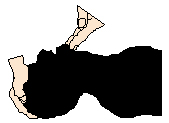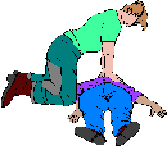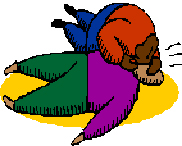Emergency First Aid and CPR
Introduction
1. If you are the first on the scene of
accident that results in an injury or serious illness, you may be the only link
between a victim and emergency medical care. Your role is to take action, whether by providing first aid, seeking
medical help. Your actions may improve the victim’s chance of recovery.
2. Bleeding
(a) Apply direct pressure to the wound (at this time a direct
pressure bandage may be used).
(b) Elevate
(do not further harm).
(c) Additional
pressure may be applied to a pressure point to help reduce bleeding.

3. Care for shock.
(a) Keep
the victim laying down (if possible).
(b) Elevate
legs 10-12 inches… unless you suspect a spinal injury or broken bones.
(c) Cover
the victim to maintain body temperature.
(d) Provide
the victim with plenty of fresh air.
(e) If
victim begins to vomit - place them on their left side.
4. First aid for sprains and strains.
(a) I-C-E
(b) I
- Ice, apply a cold pack. Do not apply ice directly to skin.
(c) C
- Compress, use an elastic or conforming wrap - not too tight.
(d) E
- Elevate, above heart level to control internal bleeding.
5. Care for dislocations and fractures.
(a) I-A-C-T.
(b) I
- Immobilize area. Use pillows, jackets,
blankets, etc. Stop any movement by supporting injured area.
(c) A
- Activate Emergency Medical Services.
(d) C
- Care for shock.
(e) T
- Treat any additional secondary injuries.
6. Poisoning.
(a) Assess
the scene for clues and safety.
(b) Get
victim away from poison if necessary.
(c) Provide
care for any life threatening conditions.
(d) Check
Material Safety Data Sheet (MSDS).
(e) Notify
medical staff or on-call Doctor.
7. Cardiopulmonary resuscitation (cpr)
abc’s.
(a) Airway
- Open the airway with the tilt-chin method.

(b) Breath
- give two breaths.
(c) Check
circulation.
(d) If
there is no pulse or breathing………
CPR Continued… Perform
chest compressions.

(e) 15
compressions and two breaths.
Count =
1&2&3&4&5…&15
(f) Rescue
breathing: 1 breath every 5 seconds - 12 per minute.

8. Universal precautions:
(a) The routine use of appropriate barrier
precautions to prevent skin and mucous membrane exposure when contact with
blood or other body fluids of any individual may occur or is anticipated.
(b) Universal Precautions apply to blood and to all other body
fluids with potential for spreading any infections.
Training
The Jawahar Institute of Mountaineering and Winter Sports (JIM&WS).
Contact Us
The Jawahar Institute of Mountaineering and Winter Sports (JIM&WS)
Address: Nunwan Pahalgam (J&K)
Telephone: 01936-243129
01936-243129 (Training Section)
01936-243002 (PA to Principal)
9906967831 (Training Clerk)
9906967822 (Sub centre, Sanasar)
9906967821 (CPIO)
E-mail CPIO: principal@jawaharinstitutepahalgam.com
Fax:01936-243129
E-mail: principal@jawaharinstitutepahalgam.com
© Copyright JAWAHAR INSTITUTE OF
MOUNTAINEERING & WINTER SPORTS NUNWAN, PAHALGAM.Corporate Mail
Design, Development and Hosting of Website by Say Technologies









